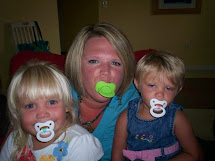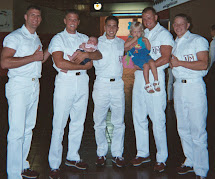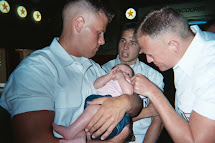Such Helpful Friends You Are
Thank you for all the wonderful emails about posting videos. What great friends I have!!!!
But I guess I should have been more specific...how do I get the video OFF OF THE CAMCORDER and onto the computer screen??? Like a special cable that plugs into the computer or do I have to burn it to a DVD first???
And how do I get JUST the part of the camcorder tape I want on that video rather than the WHOLE tape?
I'm pretty sure I can figure it out once I get it ON blogger or youtube, but it's actually getting it on there that confuses me to pieces!!!
Okay, let the help session resume!









































3 comments:
email Stephen, he'll help you!
sarnold@seaviewsmultimedia.com
Or call the house...Caleb should be asleep and Lauren goes down at 2:00 (Aggie time)
ours has a cable to get video off of our cameras same as the pictures...my daddy can be helpfulable but mom is clueless abouts it...
here's dad's respondable:
Using Windows Movie Maker (comes with Windows XP)
Newer Camera
Capture Video from a Tape in a DV Camera
Connect your DV camera to your computer, in most cases this requires an IEEE 1394 adapter on your PC and an IEEE 1394 cable to connect your camera. On the camera, set the camera mode to play the recorded video. (This is often labeled VTR or VCR on a DV camera.)
1. Start Movie Maker. To start Movie Maker, click Start, point to All Programs, point to Accessories, and then click Windows Movie Maker.
2. On the File menu, click Capture Video. Alternatively, in the Movie Tasks pane, under Capture Video, click Capture from video device.
3. On the Video Capture Device page, in Available devices, click the DV camera.
4. In the Enter a file name for your captured video box, enter a name for your captured video file. Then, in the Choose a place to save your captured video box, select the location where you want your video to be saved, or click Browse to select a location.
5. On the Video Setting page, choose the video setting you want to use for capturing video and audio.
6. On the Capture Method page, click Capture the entire tape automatically. The tape in the DV camera will rewind. Capture will begin automatically and ends when the video tape ends.
7. Select any of the following commands:
• To separate the video into smaller clips, select the Create clips when wizard finishes check box.
• To stop capturing before the end of the video tape, click Stop Capture, and then click Yes in the resulting dialog box to save the video that has been captured.
8. To close the Video Capture Wizard, click Finish.
The captured content will be imported into a new collection with the same name as the specified video file.
Old Camera
Capture Video from Tape in an Analog Camera or VCR
Analog video capture is useful when you have older video content, such as VHS tape, and want to convert it to digital. Or you may have an older camcorder that only provides analog outputs, such as composite or S-Video. Performing analog capture requires a hardware device that can take video input from a composite or S-Video signal and convert it to digital data.
To capture video in Windows Movie Maker from an analog video camera or VCR
1. Connect your analog camera or VCR to your computer's capture device, and then set the camera mode to play recorded video (often labeled VTR or VCR on an analog camera).
2. Open Windows Movie Maker
3. On the File menu, click Capture Video.
4. On the Video Capture Device page do the following:
• In Available devices, click the analog device you want to use to capture video. In the Video input source list, click the input line you want to use.
• If you want to adjust and configure the video capture device settings, click Configure.
• In the Audio device list, click the audio capture device you want to use, and then, in Audio input source, click the input line you want to use.
• To adjust the volume of your captured audio, move the Input level slider to the level you want to use.
5. In the Enter a file name for your captured video box, enter a file name for your captured video file. Then, in the Choose a place to save your captured video box, select the location where you want your video to be saved or click Browse to select a location.
6. On the Video Setting page, select the video setting you want to use for capturing video and audio.
7. To separate the video into smaller clips, select the Create clips when wizard finishes check box.
8. To prevent audio from playing over your speakers while capturing video, select the Mute speakers check box.
9. To automatically stop capturing after a time period has elapsed, select the Capture time limit check box, and then type or select the length of time you want to capture. Time is displayed in the form of hours:minutes (h:mm).
10. Using the controls on your analog camera or VCR, locate the video and audio you want to capture from your tape. In Movie Maker, click Start Capture, and then press the Play button on your analog camera or VCR.
11. To begin capturing, click Start Capture, and then press the Play button on your analog camera or VCR.
12. Do one of the following:
• When the tape reaches the point at which you want to stop capturing, click Stop Capture, and then press the Stop button on your analog camera or VCR.
• If you have selected the Capture time limit check box, wait for the specified amount of time for video to be captured, and then press the Stop button on your analog camera or VCR.
13. Repeat steps 10 through 12 for each part of the video tape you want to capture.
14. When you have finished capturing, click Finish to close the Video Capture Wizard.
good lucks!
and for just partables of the video 'stead of the whole enchilada:
Capture Parts of a Video from a Tape in a DV Camera
If you want to capture parts of a video from a tape on your DV camera, rather than the entire video, perform the first five steps in the procedure above, and then the following steps:
1.
On the Capture Method page, click Capture parts of the tape manually.
2.
To separate the video into smaller clips, select the Create clips when wizard finishes check box.
3.
To prevent audio from playing while capturing video, select the Mute speakers check box.
4.
Locate the video and audio you want to capture from your tape by using either the controls on your DV camera or VCR or the DV camera controls in the wizard.
5.
To begin capturing video, click Start Capture. The tape will play automatically and capture will begin.
6.
When the tape reaches the point at which you want to stop capturing, click Stop Capture. Repeat these steps for each part of the video tape that you want to capture.
7.
When you have finished capturing, click Finish to close the Video Capture Wizard.
The captured content will be imported into a new collection with the same name as the specified video file.
:)
Post a Comment